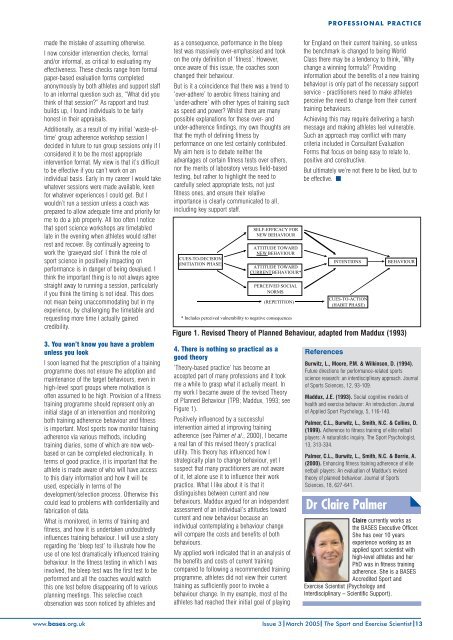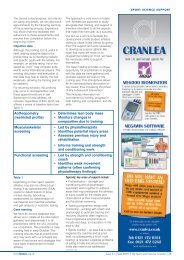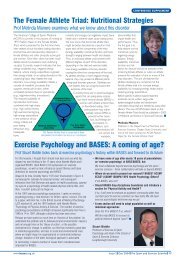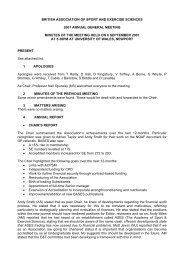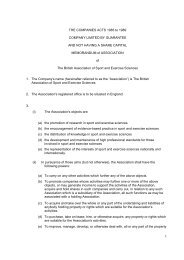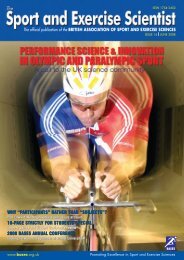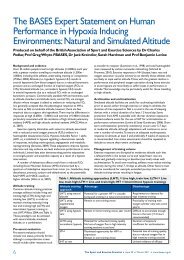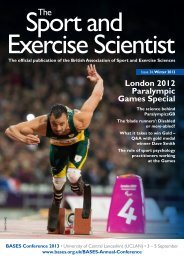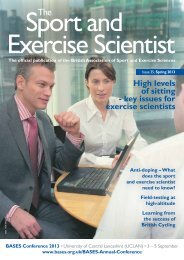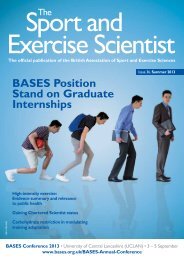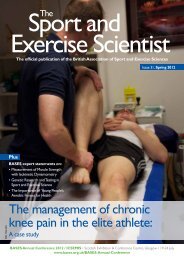Issue 3 March 2005 - BASES
Issue 3 March 2005 - BASES
Issue 3 March 2005 - BASES
You also want an ePaper? Increase the reach of your titles
YUMPU automatically turns print PDFs into web optimized ePapers that Google loves.
PROFESSIONAL PRACTICE<br />
made the mistake of assuming otherwise.<br />
I now consider intervention checks, formal<br />
and/or informal, as critical to evaluating my<br />
effectiveness. These checks range from formal<br />
paper-based evaluation forms completed<br />
anonymously by both athletes and support staff<br />
to an informal question such as, “What did you<br />
think of that session?” As rapport and trust<br />
builds up, I found individuals to be fairly<br />
honest in their appraisals.<br />
Additionally, as a result of my initial ‘waste-oftime’<br />
group adherence workshop session I<br />
decided in future to run group sessions only if I<br />
considered it to be the most appropriate<br />
intervention format. My view is that it’s difficult<br />
to be effective if you can’t work on an<br />
individual basis. Early in my career I would take<br />
whatever sessions were made available, keen<br />
for whatever experiences I could get. But I<br />
wouldn’t run a session unless a coach was<br />
prepared to allow adequate time and priority for<br />
me to do a job properly. All too often I notice<br />
that sport science workshops are timetabled<br />
late in the evening when athletes would rather<br />
rest and recover. By continually agreeing to<br />
work the ‘graveyard slot’ I think the role of<br />
sport science in positively impacting on<br />
performance is in danger of being devalued. I<br />
think the important thing is to not always agree<br />
straight away to running a session, particularly<br />
if you think the timing is not ideal. This does<br />
not mean being unaccommodating but in my<br />
experience, by challenging the timetable and<br />
requesting more time I actually gained<br />
credibility.<br />
3. You won’t know you have a problem<br />
unless you look<br />
I soon learned that the prescription of a training<br />
programme does not ensure the adoption and<br />
maintenance of the target behaviours, even in<br />
high-level sport groups where motivation is<br />
often assumed to be high. Provision of a fitness<br />
training programme should represent only an<br />
initial stage of an intervention and monitoring<br />
both training adherence behaviour and fitness<br />
is important. Most sports now monitor training<br />
adherence via various methods, including<br />
training diaries, some of which are now webbased<br />
or can be completed electronically. In<br />
terms of good practice, it is important that the<br />
athlete is made aware of who will have access<br />
to this diary information and how it will be<br />
used, especially in terms of the<br />
development/selection process. Otherwise this<br />
could lead to problems with confidentiality and<br />
fabrication of data.<br />
What is monitored, in terms of training and<br />
fitness, and how it is undertaken undoubtedly<br />
influences training behaviour. I will use a story<br />
regarding the ‘bleep test’ to illustrate how the<br />
use of one test dramatically influenced training<br />
behaviour. In the fitness testing in which I was<br />
involved, the bleep test was the first test to be<br />
performed and all the coaches would watch<br />
this one test before disappearing off to various<br />
planning meetings. This selective coach<br />
observation was soon noticed by athletes and<br />
as a consequence, performance in the bleep<br />
test was massively over-emphasised and took<br />
on the only definition of ‘fitness’. However,<br />
once aware of this issue, the coaches soon<br />
changed their behaviour.<br />
But is it a coincidence that there was a trend to<br />
‘over-adhere’ to aerobic fitness training and<br />
‘under-adhere’ with other types of training such<br />
as speed and power? Whilst there are many<br />
possible explanations for these over- and<br />
under-adherence findings, my own thoughts are<br />
that the myth of defining fitness by<br />
performance on one test certainly contributed.<br />
My aim here is to debate neither the<br />
advantages of certain fitness tests over others,<br />
nor the merits of laboratory versus field-based<br />
testing, but rather to highlight the need to<br />
carefully select appropriate tests, not just<br />
fitness ones, and ensure their relative<br />
importance is clearly communicated to all,<br />
including key support staff.<br />
CUES-TO-DECISION<br />
(INITIATION PHASE)<br />
SELF-EFFICACY FOR<br />
NEW BEHAVIOUR<br />
ATTITUDE TOWARD<br />
NEW BEHAVIOUR<br />
ATTITUDE TOWARD<br />
CURRENT BEHAVIOUR*<br />
PERCEIVED SOCIAL<br />
NORMS<br />
(REPETITION)<br />
* Includes perceived vulnerability to negative consequences<br />
4. There is nothing so practical as a<br />
good theory<br />
‘Theory-based practice’ has become an<br />
accepted part of many professions and it took<br />
me a while to grasp what it actually meant. In<br />
my work I became aware of the revised Theory<br />
of Planned Behaviour (TPB; Maddux, 1993; see<br />
Figure 1).<br />
Positively influenced by a successful<br />
intervention aimed at improving training<br />
adherence (see Palmer et al., 2000), I became<br />
a real fan of this revised theory’s practical<br />
utility. This theory has influenced how I<br />
strategically plan to change behaviour, yet I<br />
suspect that many practitioners are not aware<br />
of it, let alone use it to influence their work<br />
practice. What I like about it is that it<br />
distinguishes between current and new<br />
behaviours. Maddux argued for an independent<br />
assessment of an individual’s attitudes toward<br />
current and new behaviour because an<br />
individual contemplating a behaviour change<br />
will compare the costs and benefits of both<br />
behaviours.<br />
My applied work indicated that in an analysis of<br />
the benefits and costs of current training<br />
compared to following a recommended training<br />
programme, athletes did not view their current<br />
training as sufficiently poor to invoke a<br />
behaviour change. In my example, most of the<br />
athletes had reached their initial goal of playing<br />
for England on their current training, so unless<br />
the benchmark is changed to being World<br />
Class there may be a tendency to think, ’Why<br />
change a winning formula?’ Providing<br />
information about the benefits of a new training<br />
behaviour is only part of the necessary support<br />
service - practitioners need to make athletes<br />
perceive the need to change from their current<br />
training behaviours.<br />
Achieving this may require delivering a harsh<br />
message and making athletes feel vulnerable.<br />
Such an approach may conflict with many<br />
criteria included in Consultant Evaluation<br />
Forms that focus on being easy to relate to,<br />
positive and constructive.<br />
But ultimately we’re not there to be liked, but to<br />
be effective. ■<br />
References<br />
INTENTIONS<br />
CUES-TO-ACTION<br />
(HABIT PHASE)<br />
Burwitz, L., Moore, P.M. & Wilkinson, D. (1994).<br />
Future directions for performance-related sports<br />
science research: an interdisciplinary approach. Journal<br />
of Sports Sciences, 12, 93-109.<br />
Maddux, J.E. (1993). Social cognitive models of<br />
health and exercise behavior: An introduction. Journal<br />
of Applied Sport Psychology, 5, 116-140.<br />
Palmer, C.L., Burwitz, L., Smith, N.C. & Collins, D.<br />
(1999). Adherence to fitness training of elite netball<br />
players: A naturalistic inquiry. The Sport Psychologist,<br />
13, 313-334.<br />
Palmer, C.L., Burwitz, L., Smith, N.C. & Borrie, A.<br />
(2000). Enhancing fitness training adherence of elite<br />
netball players: An evaluation of Maddux’s revised<br />
theory of planned behaviour. Journal of Sports<br />
Sciences, 18, 627-641.<br />
Dr Claire Palmer<br />
BEHAVIOUR<br />
Figure 1. Revised Theory of Planned Behaviour, adapted from Maddux (1993)<br />
Claire currently works as<br />
the <strong>BASES</strong> Executive Officer.<br />
She has over 10 years<br />
experience working as an<br />
applied sport scientist with<br />
high-level athletes and her<br />
PhD was in fitness training<br />
adherence. She is a <strong>BASES</strong><br />
Accredited Sport and<br />
Exercise Scientist (Psychology and<br />
Interdisciplinary – Scientific Support).<br />
www.bases.org.uk<br />
<strong>Issue</strong> 3 <strong>March</strong> <strong>2005</strong> The Sport and Exercise Scientist 13


